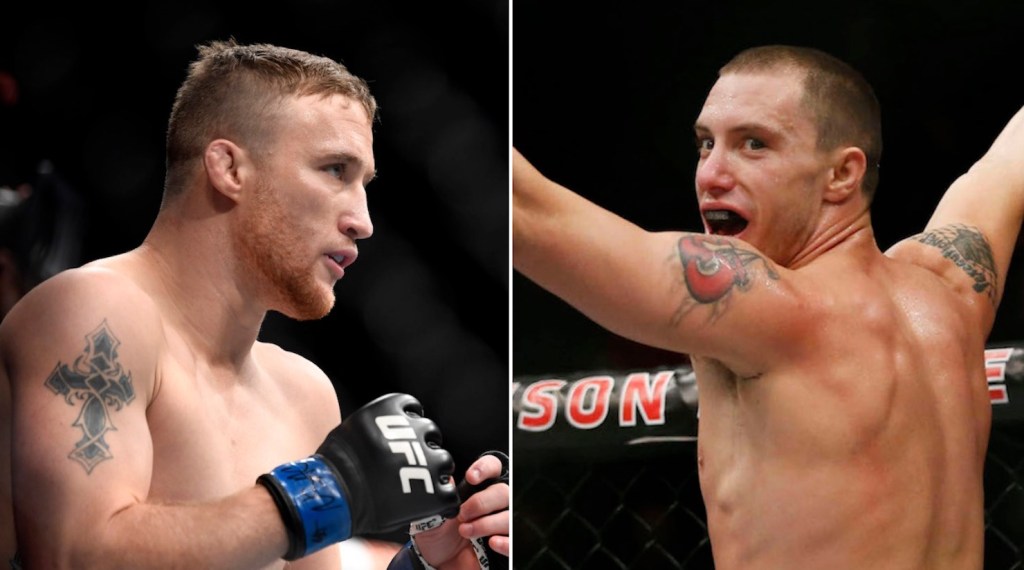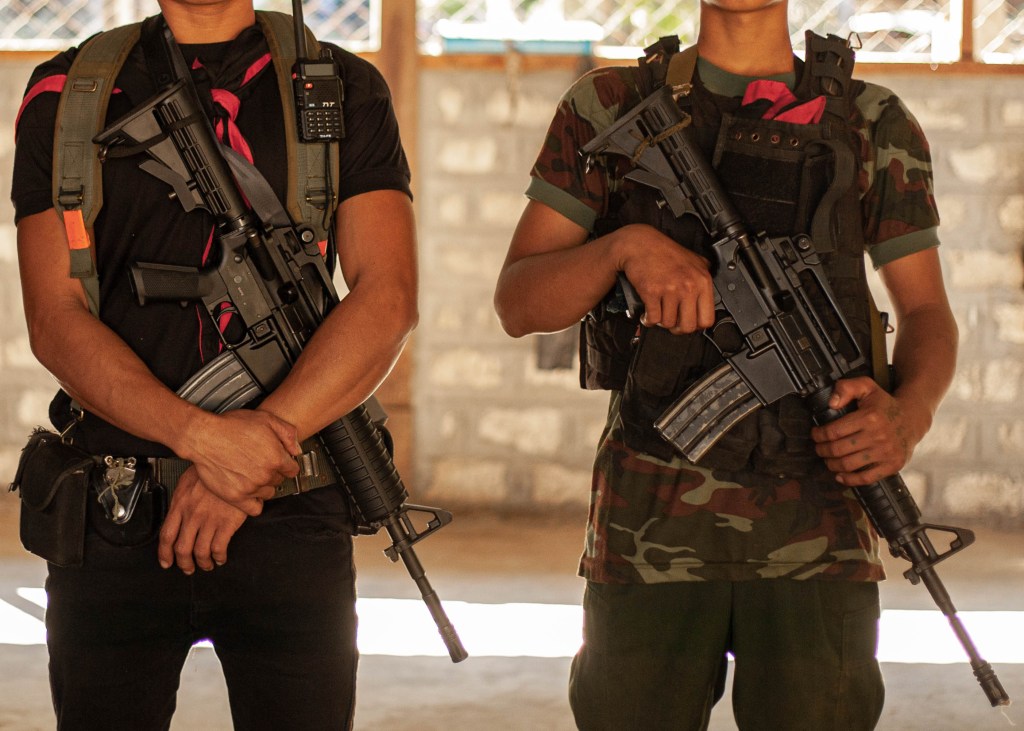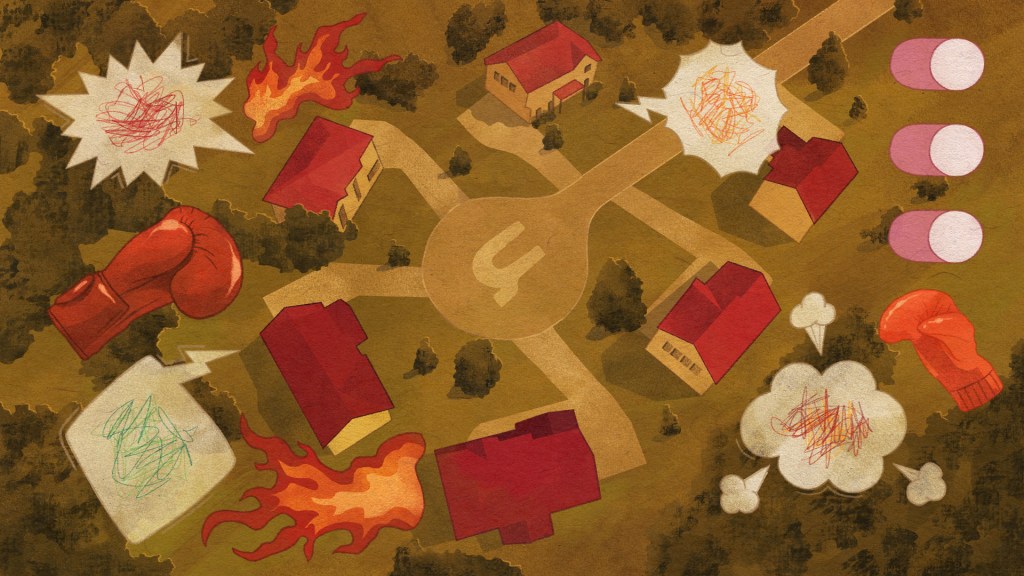The lightweight class is fit to burst, full of men who could murder a top ten opponent on any given night were they just given the opportunity. James Vick has been amongst the rabble since 2013, dodging bullets and notching victories, and after a streak of four good victories—during which he laid out the smooth Joe Duffy—Vick finally gets his crack at a top ten lightweight on Saturday night when he meets the infamous Justin Gaethje.
Gaethje is quite good enough to batter most of the best fighters in the world with his usual masochistic method, but against his two most recent opponents this gluttony for punishment has left him on the end of his only MMA losses, both brutal stoppages. Gaethje’s style is a process of throwing himself against the opponent at the same pace, minute after minute and round after round, to ascertain whether they will crumble before him. Watching Gaethje it is often unclear whether he loves to fight or hates himself.
Videos by VICE
To portray Gaethje’s style as blind, windmilling violence, would be to miss the factors that make it work so well. By crowding opponents and taking blows on his guard and the top of his head, Gaethje can retaliate with low kicks which catch the opponent as he is transferring his weight or returning to his stance. These are the low kicks which add up the quickest.
Gaethje’s style of absorbing blows against his guard and using these as the cue to trigger his counter attacks is called “catch-and-pitch” and it is perhaps the most primitive form of counter striking. Because it is done on feel and seeks to limit damage and return—rather than evade and then return—catch-and-pitch is often best for fighters who don’t quite have the speed of reflexes or footwork for the outside game. Because of Gaethje’s fondness for catch-and-pitch and wearing of enormous glasses at post-fight press conferences the writer often wonders if, like the great Joe Frazier, Gaethje’s style is actually compensating for poor vision.
Eddie Alvarez bested Gaethje by drawing him forward, flicking out jabs, and stepping in to smash Gaethje’s body. Gaethje’s high pace is tiring enough when everything is working out as he intends it to, the addition of body shots and a mobile, elusive opponent complicate matters. Dustin Poirier and Alvarez both showed the use of the jab and of partial punches. Throwing out static is important against a fighter who hopes to cover up and counter because he can be driven into a shell without committing, and then pot shotted while in that shell. Here Poirier flicks out half a dozen jabs that simply serve to keep Gaethje on the end of his reach and covering up, then sneaks through the power punches. Had the power punches gone in first, without the attempt at deception, Gaethje’s chances of taking them and coming back with power strikes of his own would have been considerably better.
Gaethje’s overeagerness to kick has also gotten him into trouble, as he was caught on one leg by both Michael Johnson and Poirier. The timing of his kicks as counters is what allows him to hobble his opponents so effectively, but by attempting to throw them in answer to everything his opponent does, he ends up standing on one leg a lot more often than would be safe.
The Texecutioner
At 6’3″, with a 76-inch reach, Vick is an oddity at lightweight. In many ways his style is reminiscent of a young Michael Bisping. His gifts are a high pace, a good one-two, an excellent double collar tie and knees from there, and constant activity when he is taken down. Unlike a young Bisping, Vick has a tremendous guillotine which has served him well throughout his UFC run both as a submission and as a deterrent.
Any time an opponent ducks in on his hips, Vick begins trying to get in front of their shoulders and snap up the choke. Rather than finishing with a classical overhand grip on his choking hand or wrist, Vick will switch to a power guillotine (occasionally ‘Buddha fist guillotine’), pushing up underneath his choking fist with his palm and turning the motion from a pull into a press. A high-profile example of this is Jon Jones’ finish of Lyoto Machida. Vick submitted Ramsey Nijem and Jake Matthews with this technique and has used it to make space to escape the fence or scramble up against plenty of others.
Whenever height and reach are called advantages in MMA, someone will chime in to remind you about Stefan Struve. The 7-foot Struve has all the gifts to be a world beater, if he had a jab to sting opponents from range and the feet and the distancing to keep them out there. Struve, unfortunately, has proven consistently hopeless in that regard and serves as proof that a height and reach advantage are only an advantage on paper—the fighter has to act to bring them to lever in a fight. Vick is a fighter who sometimes seems to have mastery of his reach and range, and other times seems uncomfortable in his own skin.
Vick consistently runs into two problems during his fights. The first is that he steps in too close and winds up on top of his opponent, head high and unprepared for their return. The second is that he will run himself backwards onto the fence almost immediately when faced with heavy pressure. These habits show up in many of his fights but seem to be more about his mindset than a consistent flaw. Against Glaico Franca, Vick looked the worst he ever has, leaving his chin high in the air as he threw himself off balance pursuing Franca and eating counters. Against Beneil Dariush it was even worse, as Dariush pressured him, stepped back when Vick attacked, and drew him into overextension. Twice Dariush got Vick to overstep himself, and twice he cracked him clean off it.
Yet against Joe Duffy, Vick demonstrated that he is more than capable of using his reach and his feet well. In that fight Vick went about getting cracked, pushed around, and backed into corners just as he had in his worst performances. Then, between the first and second round, Vick underwent a transformation. Vick was all crisp jabs and feints, long front kicks to the body and snap kicks up the middle.
Hypothetical Gameplans
Gaethje himself has mentioned concern for his health if he continues to fight in the manner that he has, so a jab and some head movement could make all the difference in the world. Rather than walking forward, waiting to absorb a solid enough punch that he feels he can get a counter off, Gaethje could be using his jab to instigate exchanges and get in on his opponent as they retaliate. The old ‘jab-and-duck’ is a staple of good boxer-infighters because it is understood as probably the best way to get to the infight without completely giving up your intentions or neglecting the outfight altogether.
Roberto Duran was the master of the jab-and-duck and would jab, move his head to a new position, and be in on a body shot by the time his opponent’s jab flicked back. If they stopped flicking jabs and right straights back? Duran would step in with a stiff one-two and put them on their rump. For more on that and the application of the jab, check out The Elements of Style: The Jab.
The two ways to best a man with a longer reach are to crowd him or to make him overcommit as he comes to you. Dariush was able to use the second method against Vick, but Gaethje is built for the first. One of Gaethje’s best blows has always been his catch-and-pitch overhand right or that same overhand right off a stiff arm along the fence. With how high Vick carries his head and how little he moves it when he is in close, Gaethje would do well to throw the overhand every time he is close enough to.
While shooting on Vick is risking the guillotine, Gaethje has had good success in the past level changing as if to attack his opponents hips and then coming up with the overhand. If he can corral Vick toward the fence he might be able to abuse him with level changes into uppercuts or—more likely—into overhands and left hooks.
Low kicking should be a staple of Gaethje’s strategy because Vick has generally done so poorly in evading them. Against Duffy and Dariush, Vick’s answer was to kick back. It worked against Duffy because Duffy is a calm, slow-paced fighter who gave him space. Against Dariush, Vick’s retaliatory kicks often carried him into a position to be countered. Gaethje’s constant pressure might make kicking back uncomfortable by keeping Vick on the move or on the back foot.
For Vick, staying off the fence is important to make use of his length and avoid prolonged wrestling generally, but in this fight more than ever he should mind his P’s and Q’s religiously because pressure is Gaethje’s entire game. If Vick can keep changing directions and have Gaethje turning and stepping as much as possible, he already has the fight swinging in his favour. If he can needle Gaethje with the jab as he advances, that will be an excellent beginning—setting up power punches later on.
The uppercut is a weapon that Vick loves—and famously caught Duffy with—but it could get him into trouble here. Yes, Gaethje ducks his head forward a lot and Poirier and Alvarez both had good success with the uppercut as a result, but Vick’s length and lack of polish on the inside make this seem like it might not be worth the risk of eating the overhand. On the plus side, Gaethje’s left hook is nothing to write home about so Vick could work his own catch and pitch—blocking or evading the right hand and returning with the uppercut.
Notice how high, undefended and stationary Vick’s head is during and following his uppercut.
A better option when caught in close, or in the clinch, would be to work to angle off and snatch up a double collar tie. Vick has shown an awareness of the advantage his height gives him in using this position in the past. Against Duffy, Vick would raise his knee and glide in, or superman punch to make distance, before falling in on the double collar tie.
While many look at the double collar tie position and think the fighter is wide open to be hit (Andy Hug haymakered his way out of the first double collar tie he encountered) a good double collar tie can be used to inhibit the opponent’s shoulder rotation, to keep him off balance, and at the very least give the fighter a heads up on when a swing is coming. With a height advantage, the knee from the double collar tie becomes an even more severe threat.
Gaethje’s forward pressure, high guard, and projected forehead mean that punching him is a thankless task. Loading up big shots and landing them on the top of his head is simply risking breaking one’s hands. Checking the hands as they are locked in the guard, and rolling over into elbow strikes, however, is always a good option against these sort of cover-up-and-advance fighters. Vertical elbows up the middle can also be used to intercept as the covering fighter steps forward.
Here Poirier turns an elbow over on Gaethje. The same principle could be seen as Conor McGregor chucked elbows through Nate Diaz’s high guard in their second fight.
Both Gaethje and Vick have existing habits and flaws which play directly into the attributes and skills of their opponent. Both men could hide some of these and stay safe behind the right game plan, but that would take a dose of humble pie and the two men have been engaged in a war of words since before the fight was even a possibility. If the combatants come in doing exactly what they always do, and butt heads over and over until one falls, it would be the least encouraging for the career longevity of both men but it would probably be another Gaethje contender for fight of the year. With plenty of other quality names on the card and no pay-per-view price tag, this really isn’t one the fight fan should be thinking about skipping.
Jack wrote the hit biography Notorious: The Life and Fights of Conor McGregor and hosts the Fights Gone By Podcast.




